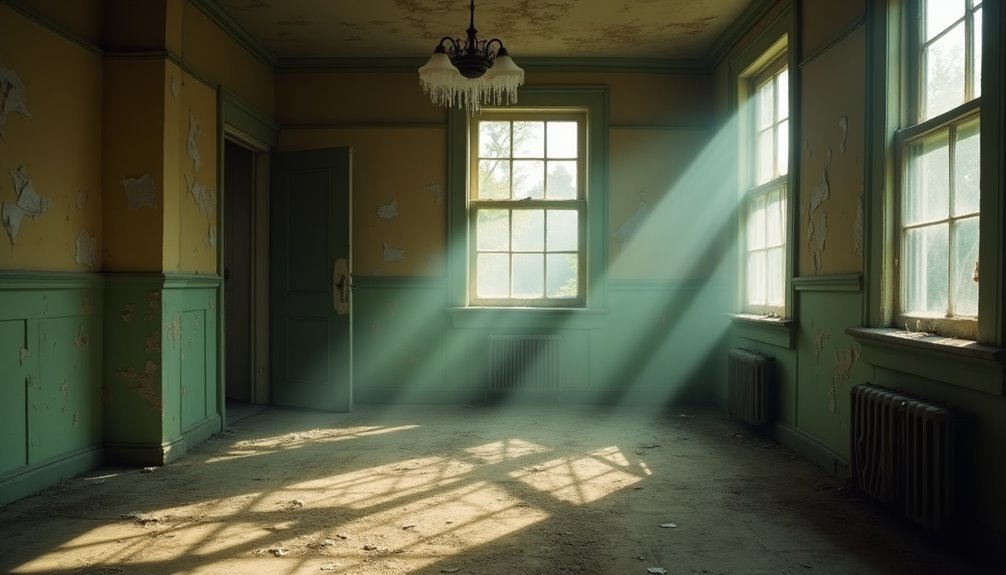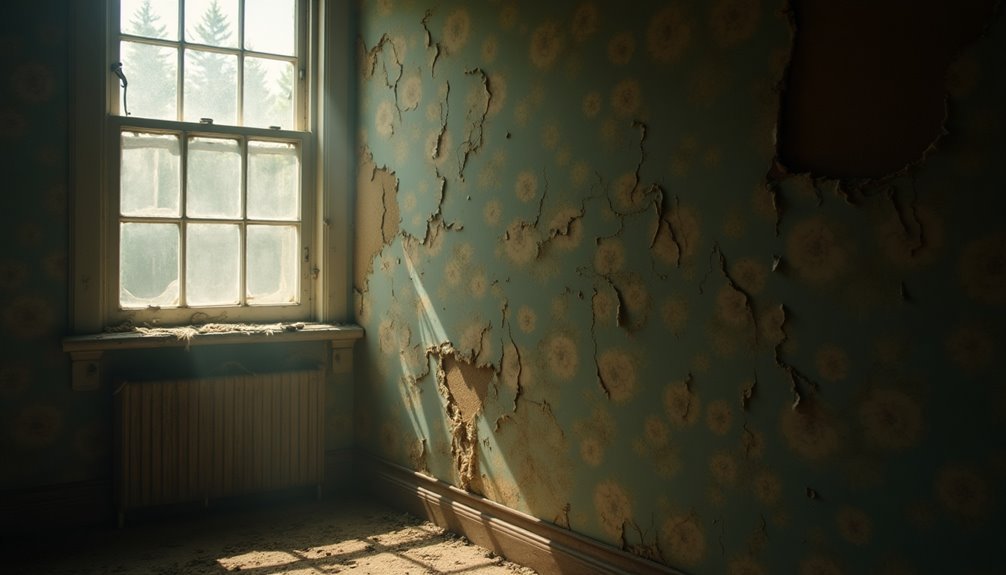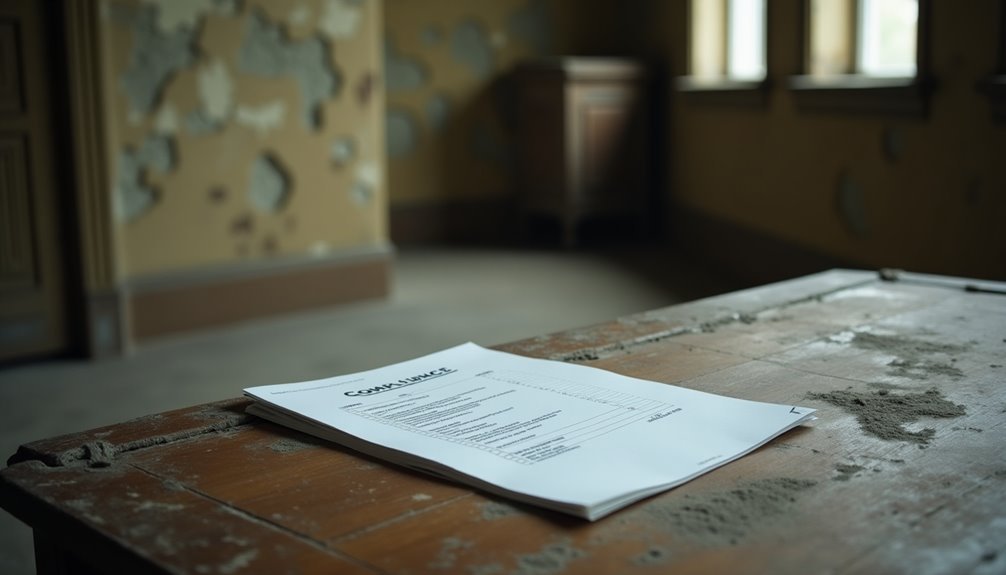As a homeowner, you can't afford to skip asbestos testing in older homes. Asbestos was widely used in construction, and its fibers pose serious health risks like asbestosis and lung cancer. Symptoms might take decades to appear, making early detection essential. High-risk areas include attics and basements, where you might find insulation or materials containing asbestos. Testing helps avoid costly remediation and ensures compliance with legal regulations. It's a proactive step toward protecting your health and maintaining a safe living environment. You'll want to stay informed about safe practices and testing methods to safeguard your home effectively.
Historical Use of Asbestos

Throughout history, asbestos has been utilized for its remarkable properties, though few realize its extensive past. Its use dates back at least 4,500 years to the Stone Age, where ancient applications included strengthening earthenware pots in Finland. Ancient civilizations also crafted shrouds from asbestos, ensuring that the ashes of their kings endured beyond death. The Greeks recognized both the utility and the dangers of asbestos, noting the "sickness of the lungs" among laborers who handled it.
The Industrial Revolution reignited the demand for asbestos in the late 1800s. As industrial practices evolved, asbestos became integral in insulation for steam pipes, boilers, and kilns, thanks to its thermal and electrical insulating properties. By the mid-19th century, asbestos-laden products began commercial production, and large-scale mining commenced to satisfy manufacturers' needs. In fact, approximately 255,000 deaths annually are attributed to asbestos-related diseases, highlighting the severe health implications associated with its widespread use.
From construction materials to fireproofing, asbestos found its way into nearly every aspect of building. The peak use of asbestos in the 20th century set the stage for broader awareness of its risks, ultimately leading to significant declines in its application due to health concerns. Understanding this history is vital as you navigate older homes today.
Health Risks of Asbestos
Understanding the historical use of asbestos is vital for recognizing the potential health risks associated with exposure in older homes. Asbestos fibers can cause serious diseases, including asbestosis, mesothelioma, and lung cancer when inhaled. When these fibers lodge in lung tissue, they lead to inflammation and scarring, manifesting as asbestos symptoms like coughing and shortness of breath.
It's crucial to note that asbestos-related diseases often develop 15 to 50 years after initial exposure. The risk isn't limited to just respiratory illnesses; studies suggest that exposure may increase the risk of digestive system cancers as well. If you've been exposed, be vigilant for symptoms like chest pain or difficulty swallowing. All asbestos fibers are harmful if breathed, making it imperative to take potential exposure seriously.
To mitigate these risks, exposure prevention is key. If you suspect the presence of asbestos in your home, don't attempt to handle it yourself. Instead, hire trained professionals for testing and removal. Remember, undisturbed asbestos poses little risk, but damaged materials release hazardous fibers. Regular screenings by a qualified lung specialist are also advisable for anyone with known exposure. Being proactive is essential for safeguarding your health and that of your loved ones.
Identifying High-Risk Areas

Many older homes harbor hidden dangers, particularly in areas where asbestos may be present. To safeguard your health, you'll need to identify high-risk zones within your home. Start with attics, where vermiculite insulation, often containing asbestos, is common. Basements can also be problematic, as insulation, pipes, and flooring materials might harbor asbestos fibers.
Ceilings deserve attention too; ceiling tiles and joint compounds may contain this hazardous material. Don't overlook crawl spaces, as insulation and duct/pipes can present risks. Additionally, check your floors—vinyl tiles and cement flooring often contain asbestos.
When assessing these areas, consider scenarios that could disturb asbestos, such as renovations or natural disasters. Even routine maintenance can inadvertently release harmful fibers.
Conducting an asbestos inspection is crucial for a thorough risk assessment. To mitigate danger, hire accredited professionals who specialize in asbestos testing and management. Avoid touching or disturbing any suspected materials, and limit access to these high-risk areas until you receive confirmation from experts. By understanding where asbestos is likely to be found, you can take proactive steps to protect yourself and your loved ones.
Importance of Testing
Testing for asbestos in older homes is crucial for safeguarding your health and ensuring legal compliance. As you become more aware of asbestos, understanding the importance of testing can empower you to take proactive measures. Here are some key benefits of asbestos testing:
- Health Protection: Early detection can prevent serious health issues linked to asbestos exposure, including respiratory problems and lung cancer.
- Legal Compliance: Different regulations exist regarding asbestos management. Testing helps you stay compliant and avoid fines or legal actions.
- Financial Savings: Identifying asbestos early can mitigate costly remediation efforts and protect your investment.
Asbestos Testing Methods

When it comes to identifying asbestos in older homes, employing reliable testing methods is essential for accurate results. You should start with proper sample collection, which must be conducted by trained professionals to prevent the release of harmful fibers. Sampling is particularly important if you notice damage to materials like drywall or insulation, or if you're planning remodeling.
Once samples are collected, they're typically examined using various microscopy techniques. The initial analysis often involves stereo-microscopy, providing a three-dimensional view of the fibers, helping analysts identify them based on appearance and physical properties. This initial assessment guides the choice of refractive index (RI) liquid for further examination.
For a more detailed identification, Polarised Light Microscopy (PLM) is employed, allowing experts to analyze the samples for characteristics like morphology and color. Advanced techniques like Transmission Electron Microscopy (TEM) and Scanning Electron Microscopy (SEM) can detect finer fibers and provide critical details on fiber size and composition when necessary.
Safe Removal Practices
When it comes to asbestos removal, you should always hire licensed professionals to ensure safety and compliance. These experts follow EPA guidelines to manage the hazardous material properly, reducing risks to both workers and residents. Relying on trained individuals not only protects your health but also minimizes potential legal liabilities.
Licensed Professionals Only
Hiring licensed professionals for asbestos removal is crucial to ensuring safe practices and compliance with regulations. By choosing certified contractors, you benefit from their extensive training and experience, which is vital for effective asbestos management. Make sure to check for certification verification and request references from previous clients to confirm their credibility.
Consider these key points when hiring a contractor:
- Regulatory Compliance: Certified professionals adhere to federal and state regulations, minimizing legal risks.
- Expertise and Safety: Their training allows for proper preparation, containment, and safe removal techniques, significantly reducing health risks.
- Proven Track Record: Contractors with a history of successful asbestos abatement can provide peace of mind.
EPA Guidelines Compliance
Compliance with EPA guidelines is essential for safe asbestos removal practices in older homes. Ignoring these regulations can lead to dangerous exposure for you and your family. To ensure proper compliance, consider using a compliance checklist that covers key requirements before any demolition or renovation takes place.
| Step | Requirement | Purpose |
|---|---|---|
| Notification | Notify state agency prior to work | Ensures oversight and safety compliance |
| Inspection | Thorough inspection for RACM | Identifies hazardous materials |
| Work Practices | Keep RACM wet during removal | Reduces airborne asbestos fibers |
You must inspect your home for Regulated Asbestos-Containing Material (RACM) and ensure all associated cleanup and removal tasks align with federal, state, and local laws. Using wet cleanup tools and HEPA filters can significantly minimize the spread of asbestos dust. After removal, properly label and securely contain all asbestos materials to avoid contamination. Following these asbestos regulations not only protects you but also liberates your living space from potential hazards. Prioritize safety and compliance to ensure a healthier environment for everyone in your home.
Legal Considerations and Compliance

Navigating the legal landscape surrounding asbestos testing and compliance can be complex, particularly for homeowners and contractors involved in renovation or demolition projects. Understanding your legal obligations is essential, as state regulations can vary greatly. Here are some key considerations:
- Disclosure: While federal law doesn't mandate disclosure of asbestos, some states do, so check local requirements.
- Testing Requirements: Many states require an asbestos survey before any construction work, especially in buildings over a certain age.
- Documentation and Permits: Filing the necessary documentation with local authorities is crucial, particularly if asbestos is found.
Failure to comply with these regulations can lead to severe penalties and fines. Enforcement agencies actively monitor compliance, and violations can result in legal consequences not just for property owners but also for contractors. Thus, it's vital to work with certified asbestos inspectors and keep all compliance documents on file. By staying informed and adhering to state regulations, you protect yourself, your workers, and your property from the potential hazards and legal ramifications associated with asbestos.
Conclusion
In conclusion, ignoring asbestos testing in older homes can be a ticking time bomb for your health. With the serious risks associated with exposure, you can't afford to take chances. By identifying high-risk areas and utilizing proper testing methods, you can protect yourself and your loved ones. Remember, it's not just about compliance; it's about safety. Don't let asbestos lurk in the shadows of your home—take action today to ensure a safer tomorrow.
